R&D Activities
Organic Chemicals Division
To contribute to steady food production throughout the world, ISK is working to develop highly safe, environmentally compatible, highly effective agrochemicals. In recent years, ISK has been involved in the development of a variety of products for medical use and the healthcare of animals.
ISK’s stance on R&D is to develop products that will match precisely the needs of users.
Bioscience Field
Based on our common understanding, “Agrochemicals are positioned as critically important substances for steadily securing food in preparation for the growth of the world population in the future,” ISK is carrying out R&D daily to create highly safe and effective agrochemicals.
The agrochemicals we have invented newly and developed around the world are contributing to the steady production of food and the reduction of users’ tasks. Our painstaking safety evaluation of the agrochemicals we produce leads to their prompt registration in each country as environmentally friendly chemicals. These endeavors bear fruit in the forms of worldwide development, registration, commercialization, and sales of many chemicals.
Research Field/Framework
*You can see the entire image in the figure by scrolling horizontally.
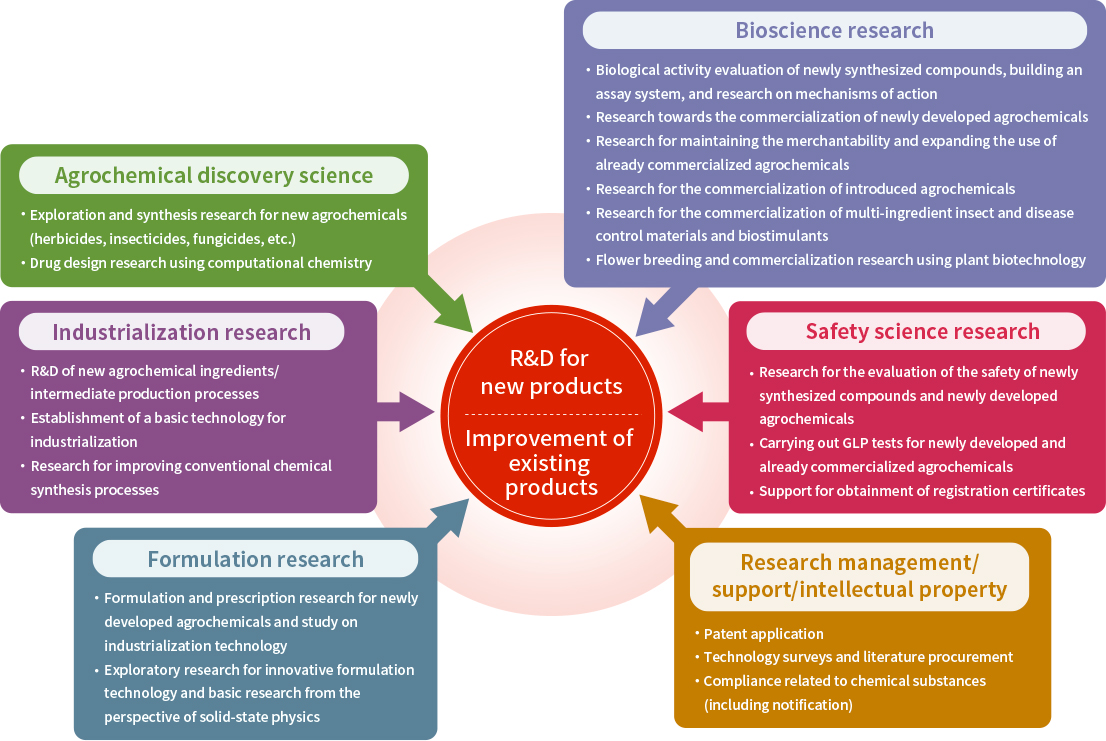
Development Story
-
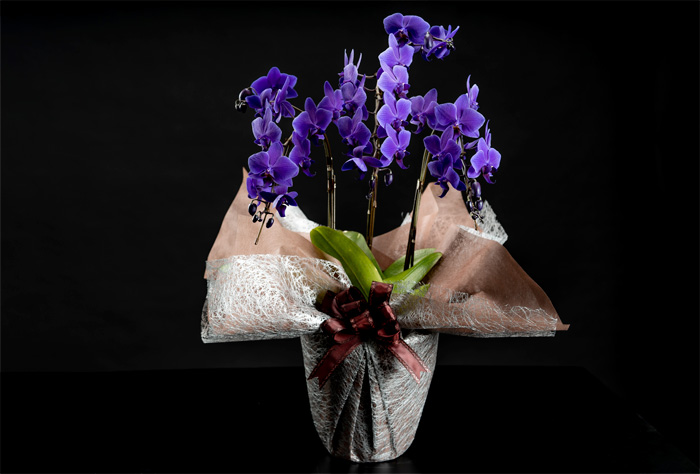
The world’s first blue Phalaenopsis created using biotechnology
Blue Phalaenopsis has been pursued for many years as a phantom flower that does not exist in nature. Using its proprietary technology, ISK successfully developed the world’s only blue Phalaenopsis Blue GeneTM, after more than 15 years of research.
A long-term project begins with the aim of creating a phantom blue Phalaenopsis, or moth orchid
Phalaenopsis orchids delight the eye with their beautiful colors, including white, pink, and yellow. They are popular as a special gift because, in addition to its gorgeous appearance, it takes over four years to bloom.
While they bloom in various colors, the blue Phalaenopsis orchid does not exist naturally. In fact, the moth orchid lacks genes for producing blue pigments (delphinidin-type anthocyanin). In the past, white moth orchids have been treated with a dye solution to make them blue, but these are only artificial. For this reason, a naturally blue moth orchid has become something that many people look forward to seeing.
ISK began developing blue moth orchids in 2005. A researcher with experience in pharmacological testing of the compound that would become the archetype of the veterinary drug BrendaTM led the research and applied the technology gained from his research experience to take on the challenge of genetically modifying plants.
There is a compatibility issue between plant species and the blue gene. If you put a gene that is incompatible with Phalaenopsis, no blue pigment will be produced. No one can know how long it will take to find a compatible gene. Moreover, it takes four years for the plant to produce flowers after the modified genes are introduced. With an understanding that the research would take a long time, the researcher tested compatibility using plants with natural blue genes.
In 2006, joint research began with Chiba University, which boasts a strong track record in the field of genetic modification of flowers. Overcoming temporary suspension of the research due to deterioration of the company’s business performance, ISK has continued research and development on its own since 2013.Noble, bright blue Phalaenopsis created after 17 years, passed on to the next generation
Through trial and error to find compatible genes, the researcher arrived at Commelina communis var. hortensis, a cultivar of Asiatic dayflower with an impressively beautiful blue color. The cultivar has been grown in Kusatsu City, Shiga Prefecture—where ISK’s Central Research Institute is located—since long ago and is designated as the city’s flower. In ancient times, it was used to draw sketches for yuzen dyeing. Focusing on the vividness of the blue color of Commelina communis var. hortensis, the researcher used the blue gene from its original species, Asiatic dayflower. The result was that a brilliantly blue moth orchid bloomed, that blue gene being highly compatible with the Phalaenopsis orchid.
After dozens of tests to investigate whether there were any risks due to toxicity or hybridization with wild species, the variant finally received approval* from the Japanese government in March 2021. The blue Phalaenopsis, named Blue GeneTM following a company vote, received high praise at events such as the historic JGP International Orchid and Flower Show and the Japan Flower Selection. Furthermore, it received the Flower of the Year 2022 prize (best award) from the Japan Flower Selections, which is given to new varieties most recommended to consumers from the industry’s point of view.
Going forward, ISK will continue to take on new challenges such as increasing the size of Blue GeneTM and using the blue moth orchid as the mother plant to develop bluish Phalaenopsis cultivars. Additionally, challenges include introducing genes derived from Asiatic dayflower into other flowers for improved diversity and extending the lifespan of flowers.* Approval of regulations on Type-1 use in accordance with the provisions of Article 4, Paragraph 1 of the Act on the Conservation and Sustainable Use of Biological Diversity through Regulations on the Use of Living Modified Organisms
-
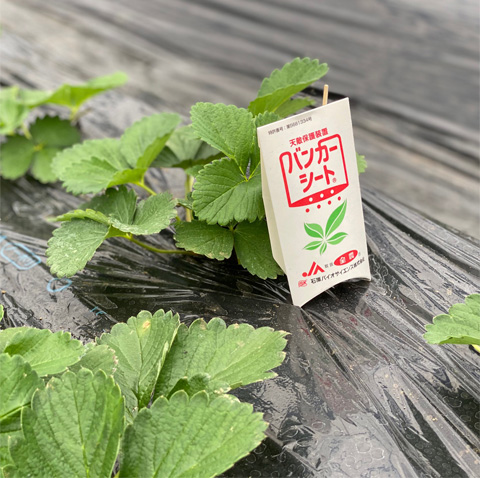
Revolutionary Biopesticides Contribute to Sustainable Agriculture
Biological pesticides have been attracting more and more attention in recent years due to people’s growing interest in environmental issues and food safety. ISK, which has been involved in the research and development of agrochemicals for many years, currently offers biological and microbial pesticide products, such as CHIRIGABURITM, AKAMETM, Miyako-bankerTM, Swaru-bankerTM, Swaru-bankerTM Long, and MinitanTM WG.
Starting development of biopesticides as a complement to chemical pesticides
Biological pesticides are environmentally friendly pesticides made from living insects, microorganisms, bacteria, and the like that exist in nature. ISK has been working on developing them since around 2000.
The field of Integrated Pest Management (IPM)1 is expected to grow both domestically and internationally. Accordingly, developing biological pesticide products in addition to chemical ones is a powerful strategy that will lead to increased sales both in Japan and abroad. Most of our chemical pesticides, including those under development, are compatible with biological pesticides. We are also actively working on the development and commercialization of environmentally friendly and safe pesticides. We have created our own IPM system that combines these elements and have strived to realize a pest control technology system that is not only environmentally friendly and highly safe but also truly effective. We believe that the development and dissemination of biological pesticides are valuable in order to avoid the development of pesticide resistance and allow our chemical pesticides to be used for a longer period of time.-
1Managing damage below the economic injury level by combining various techniques
Realizing agriculture that is friendly to people and nature by combining chemical pesticides, biopesticides, and ICM technology
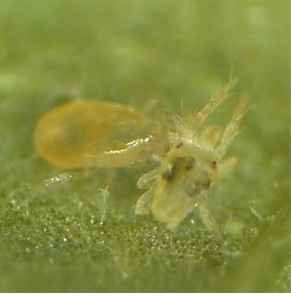 Neoseiulus californicus (McGregor) preying on two-spotted spider mites
Neoseiulus californicus (McGregor) preying on two-spotted spider mitesThe Biopesticide Research Group of ISK successfully developed Banker-SheetTM and launched it on the market in 2016. The Banker-SheetTM technology is a device that protects natural predators of pests by packing them live in small packs into Banker-SheetTM (a box made of water-resistant paper) along with felt and water-absorbing resin. Banker-SheetTM reduces and stabilizes internal humidity fluctuations. The water-absorbing resin sealed in has the function of increasing internal humidity. The favorable environment for natural predators provided by Banker-SheetTM helps natural predators establish themselves in fields that are exposed to severe environmental fluctuations (low humidity, rainfall, etc.). The technology for commercializing Banker-SheetTM was established through the Science and Technology Research Promotion Program for Agriculture, Forestry, Fisheries and Food Industry (26070C). This successful development led to the commercialization of Miyako-bankerTM, which is a set of the Neoseiulus californicus McGregor formulation that preys on spider mites and Banker-SheetTM at the end of 2016, and also of Swaru-bankerTM, which is a set of Amblyseius swirskii Athias-Henriot that preys on thrips, whiteflies, and the like and Banker-SheetTM in the spring of 2017. In 2022, we produced Swaru-bankerTM Long, which is an enhanced version of Swaru-bankerTM. With a longer release period of natural predators compared to conventional products, Swaru-bankerTM Long is expected to provide stable pest control effects. For the development and popularization of Banker-SheetTM, we received the Agriculture, Forestry and Fisheries Research Council Chairman’s Award in the Private Enterprise Category of the 2022 Private Sector Agriculture, Forestry and Fisheries Research and Development Achievement Awards, and the Horticulture Research Achievement Award as well.
In the field of fruit trees, in which biopesticides are still in the process of becoming widespread, we have established a double-natural predator control system2 that combines Banker-SheetTM technology and indigenous natural predators that live in orchards (Program to Promote Research for Strengthening of Innovation Creation [28022C]). As an outcome of this popularization and development, we received the Adaptation Grand Prize in the Development and Commercialization Category of the FY 2021 Environment Minister’s Awards for Climate Change Action. 3
In February 2022, the development and research group moved an evolutionary step forward from IPM to integrated crop management (ICM) to tackle research and development from a broader perspective on crop management, not just biopesticides. This will not only create new biological pesticides and improve their utilization technology but also advance the development of environmentally friendly and safe pesticides. We will also take on the challenge of developing biostimulant materials. Furthermore, by developing our own ICM technology, we will help achieve sustainable agriculture.2 Double-natural predators: A spider mite control method that greatly reduces dependence on acaricides by utilizing natural predator formulations in conjunction with indigenous natural predators (natural predators that originally live in the area) on fruit trees
3 Award winner emblem of FY 2021 Environment Minister’s Awards for Climate Change Action

-
-
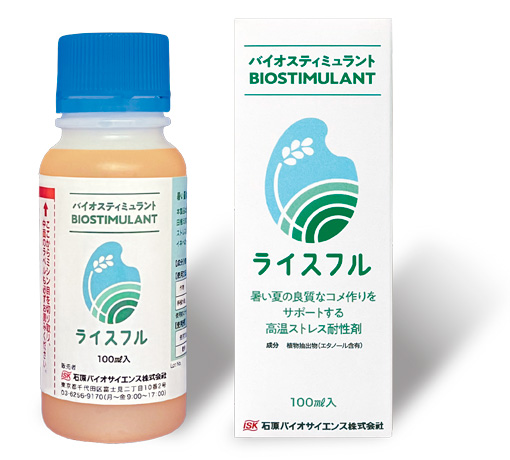
Development of RicefulTM, a Biostimulant Shaping the Future of Agriculture
ISK’s Proprietary Technology for Rice Production Resistant to Intense HeatIn recent summers where the heat has become more severe year by year, damage to rice plants due to high temperatures has become a problem. Against this backdrop, ISK began developing a product that would allow farmers to produce rice that could withstand high temperatures. Biostimulants are a new agricultural material attracting attention around the world. Using the biostimulant and applying its proprietary technology, ISK has completed RicefulTM.
Power of biotechnology leveraged to produce rice that withstands intense heat
In recent years, there has been a noticeable trend towards higher temperatures during the rice growing period. Data has been reported that brown rice obtained from paddy rice exposed to high temperatures during the grain filling period (anthesis to maturity) deteriorates in appearance, quality, taste, and texture.
To reduce high-temperature damage to paddy rice, efforts have been made to create varieties that can withstand high temperatures and to develop techniques to avoid high temperatures through cultivation management. However, it is difficult to improve the situation using existing techniques alone.
Therefore, to develop products that reduce high-temperature damage, we focused on biostimulants that improve plants’ resistance to severe abiotic stresses such as heat and drought and bring out their true potential. We have been conducting research and development with the aim of providing our own unique technology.Two barriers in biostimulant development
We had two major challenges to overcome during development. One was that there were no laws governing biostimulants in Japan, so we had to determine internal standards for performance, safety, product standards, and the like to commercialize the product. The top priority was that the product be used by both producers and consumers with peace of mind. We acquired the data we believed was necessary through repeated discussions among relevant departments based on the technology we had built through the development of agrochemicals.
The other was that the mechanism of action of biostimulants (the mechanism by which the product exerts its effects) is extremely difficult to elucidate. Pesticides act directly on biological stresses such as diseases and pests. Unlike them, biostimulants work to improve the inherent resistance of rice, so they generally have a very complex mechanism of action and require a long time to clarify it.
In some cases, annual fluctuations, including inconsistency such as that the environment in fact was not so harsh in terms of high temperature stress, could blur the efficacy. If the efficacy is not apparent, producers will not be able to understand the utility value of the product. Therefore, we have conducted repeated tests over many years to demonstrate its efficacy and focused on elucidating the mechanism of action. We then made a development proposal within the company, carefully and repeatedly explaining that improving the quality of brown rice would lead to higher profits for agricultural producers. In this way, we conducted research from an unprecedented perspective while taking into account the characteristics of biostimulants.Evolution of technology resulting in RicefulTM and further expanding possibilities
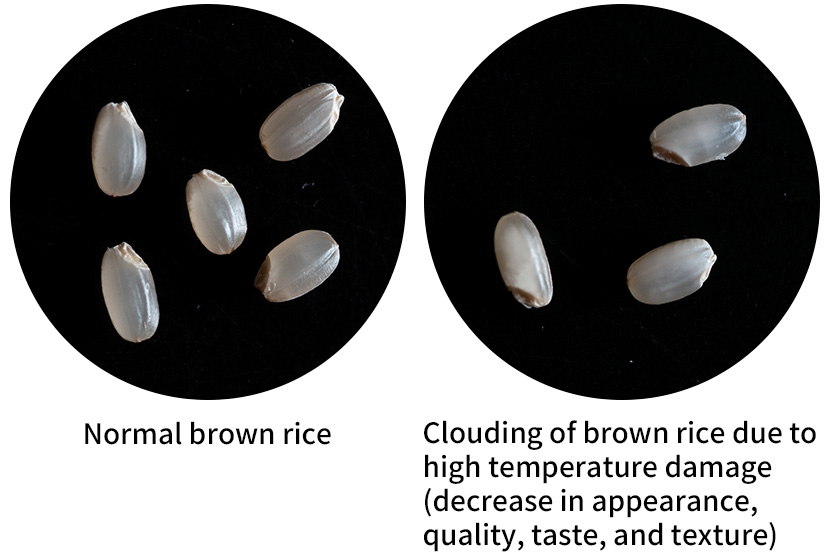
Through trial and error, we completed development of the biostimulant RicefulTM, using our unique technology. The product was launched in March 2023.
RicefulTM is made from ingredients extracted from plants that are also used in food; to use it, it is sufficient to spray a diluted solution on the seedling box.
Prior to its release, we conducted a RicefulTM giveaway campaign targeting rice farmers. More applications and responses than expected were received, revealing a high level of interest in alleviating high-temperature stress in paddy rice.
With the development of RicefulTM, we have added a new biostimulant product to our line of products. We will continue to evolve and take on challenges, including expanding the effective ways to use RicefulTM and enhancing our line of products.
Agrochemicals developed in-house that are now on sale (Order of information: generic name, Japanese trade name, year of registration in Japan)
-
Pyrazoxyfen, PAICERTM, 1985, 3 countries
Pyrazoxyfen is a rice herbicide which controls a wide range of weeds in paddy fields. It provides long residual weed control when it is applied at preemergence to early postemergence timig. Pyrazoxyfen is commercialized as a component of mixture products such as "ONEBESTTM", "ONEALLTM", and "TOBIKIRITMJUMBO" in Japan.
-
-
Fluazifop-P-butyl, ONECIDETM-P, 1986, 20 countries
Fluazifop-P-butyl is a postemergence herbicide with high efficacy against annual and perrenial grass weeds. As it is non-toxic to broadleaf plants, this herbicide is registered for use in a variety of broadleaf crops such as soybean, oilseed rape, sugar beet and potatoes.
-
Flazasulfuron, SHIBAGENTM, 1989, 35 countries
As a sulfonylurea herbicide, flazasulfuron is used at very low dose and provides long-term herbicidal effects on a wide variety of weeds in orchards, warm-season turf, and non-crop areas.
-
Nicosulfuron, ONEHOPETM, 1994, 58 countries
Nicosulfuron is a sulfonylurea herbicide for weed control in corn. It controls both grass and broadleaf weeds. Because of its outstanding performance, Nicosulfuron has been used by corn growers globaly since it was launched in the early 1990's.
-
Tolpyralate BRUCIATM, 2016
A photosynthesis-inhibiting foliage-applied herbicide Tolpyralate shows excellent selectivity for feed-grade corn and can control annual grass and broadleaf weeds at the same time. In Japan, the herbicide has been registered for use with food-grade corn, following feed-grade corn, and is currently being sold. The product has been registered in the United States and Canada; its development is underway in Europe, Central and South America, and Asian countries.
-
Fluazifop-P-butyl, ONECIDETM-P, 1986, 20 countries
-
-
Chlorfluazuron ATABRONTM, 1988
Chlorfluazuron is one of our groundbreaking insect growth regulators (IGRs). It inhibits the biosynthesis of chitin, a material contained in the outer skin of insects. It has strong insecticidal activity against lepidopteran, thysanopteran, and hemipteran larvae.
-
Fosthiazate NEMATHORINTM, 1992
Fosthiazate is a low-toxicity organophosphorous nematicide. This non-fumigating agent is effective against all nematode development stages at low concentrations. It has moderate soil residual activity. Because fosthiazate has superb systemic activity in plants, it can also control foliar pests such as spider mites, thrips, and whiteflies by soil application.
-
Flonicamid, ULALATM, 2003
Flonicamid is an insecticide that enables integrated pest management (IPM) because it is safe for natural predators and insect pollinators. It is very active against aphids, and also effective against some other species of sap-sucking pests (hemipterans and thysanopterans). This compound has a unique action that controls pests by inhibiting their sap-sucking behavior. Flonicamid is effective against resistant strains, because its mode of action differs from that of existing insecticides.
-
Cyclaniliprole, TeppanTM, 2017
Cyclaniliprole is a diamide insecticide with an anthranilamide structure having a wide insecticidal spectrum that is active against not only various lepidopterous insect pests but also the Coleoptera, Thysanoptera, Diptera, Hemiptera, and various other insect pests. It is currently being developed around the world for a wide range of crops including vegetables, fruit trees, tea, paddy rice, and soybeans. As of February 2018, it has been registered in South Korea, the United States, Canada, and Japan.
-
Chlorfluazuron ATABRONTM, 1988
-
-
Fluazinam, FROWNCIDETM, 1990, 58 countries
Fluazinam is a multi-site contact fungicide with broad spectrum activity, that belongs to the pyridinamine family. Furthermore, it has acaricidal activity. It shows no cross resistance against resistant of other fungicides. It is also active against diseases that are difficult to control like the white root rot of fruit trees and the clubroot of Brassicaceae vegetables. It is recognized as an agent for controlling tuber blight on potato in Europe and Japan.
-
Cyazofamid, RANMANTM, 2001, 55 countries
Cyazofamid is highly selective and effective against Oomycetes which are pathogen of downy mildew or late blight, and Plasmodiophoromycetes which induce clubroot of Brassicaceae vegetables.. It belongs to chemical class of cyanoimidazole and has novel mode of action inhibiting the Qi site of complex III, which consists of electron transport system in the mitochondrial inner membrane.
-
Pyriofenone, CROSSOUTTM, CASSINITM, 2013, Japan
New benzo-pyridinamine fungicide having outstanding efficacy for various types of powdery mildew.
Pyriofenone treated fungi shows unique phenotypes such as incomplete cell wall synthesis, suppression of cell penetrating organ, haustorium, formation, and incomplete spore formation cased of new mode of action affecting actin localization, which is consist of cytoskeletons in fungi cells. -
Isofetamid, KENJATM, 2017, Japan
A broad spectrum fungicide with outstanding effectiveness against gray mold, Sclerotinia disease, and other diseases on fruits and vegetables
The mode of action is the succinate dehydratase inhibition (SDH inhibitor) in mitochondrial electron transport systems. Isofetamid shows efficacy against resistant strains of other SDH inhibitor fungicides.
-
Fluazinam, FROWNCIDETM, 1990, 58 countries
-
ISK’s products available for sale include Swaru-bankerTM, Swaru-bankerTM Long, and Miyako-bankerTM, which are sets of Banker-SheetTM and a natural predator, namely, one of two species of Phytoseiidae, as well as AKAMETM, which eats thrips and CHIRIGABURITM, which feeds on spider mites. Banker-SheetTM is a set of easy-to-assemble components. It protects natural predators from chemical pesticides and environmental changes and can breed natural predators and release them over a long period of time. The technology for commercializing this product was established through Agriculture & Food Project 26070C.
Healthcare Field
Veterinary Drug
Taking advantage of our new pesticide discovery technology that we have fostered so far, we address development of innovative veterinary drugs to protect companion animals’ lives and health.
At present, compared with the medicinal products for human use, those for animal use that are available to veterinarians are limited in terms of fields and types. Therefore, actually the medicinal products for human use are used off-label at a veterinarian’s discretion in clinical settings. However, there are differences in drug sensitivity and metabolism between humans and animals. Application of the medicinal products for human use to treatment of animals entails great risk and often causes serious accidents.
In order to reduce this risk in clinical settings and ensure healthy life of companion animals as family members, we attempt to promote discovery of new drugs to meet the needs of veterinarians and owners of these animals mainly in the fields of diseases for which no veterinary drugs have been developed.
*You can see the entire image in the figure by scrolling horizontally.
| Fuzapladib sodium | Summary of product characteristics | The anti-pancreatitis drug for dogs, ‘BrendaTM’, was approved domestically in September 2018. The product was approved in the United States as PanoquellTM-CA1 in November 2022 and obtained domestic approval as PanoquellTM in September 2024. BrendaTM and PanoquellTM are an anti-inflammatory drug with a new mechanism of action that enables prevention of activation of cell adhesion molecules and inhibition of leukocyte adhesion and infiltration at the site of inflammation. |
|---|---|---|
| Clinical development | To provide this drug for all the owners of companion animals and animal health professionals in the world including Japan, we are currently addressing clinical development in various countries around the world. | |
| Expanded use | Because fuzapladib sodium has a unique made of action, its expanded use in treatment of other inflammatory diseases is expected. |
